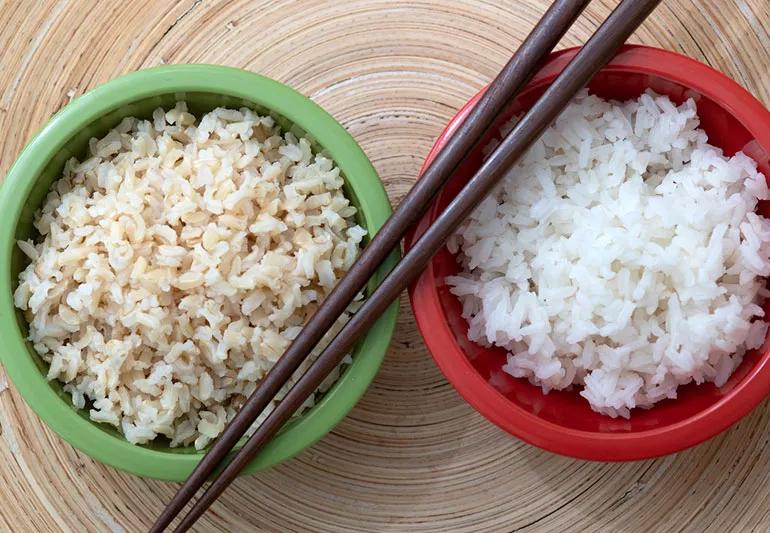The answer is clear, but there are factors to consider

Which is healthier: Brown rice or white rice? A nutritional tale of the tape provides a clear winner by knockout. “Hands down, brown rice brings more to the table,” says registered dietitian Beth Czerwony, RD.
Advertisement
Cleveland Clinic is a non-profit academic medical center. Advertising on our site helps support our mission. We do not endorse non-Cleveland Clinic products or services. Policy
But brown rice might not always be your best choice depending on some personal health factors. (Nothing is ever 100%, right?)
So let’s break it down with Czerwony in a little Rice 101.
Approximately 20% of the world’s calorie intake is connected to the humble rice grain, making it one of the most important foods on the planet. More than 3.5 billion people rely on rice as a daily staple of their diet.
To feed that need, farmers grow more than 100,000 different varieties of rice in a rainbow of colors. Thankfully, though, your mealtime choice typically gets narrowed down to a pair of options: brown or white.
Out of the two, white rice is far and away the most common to find on your plate – largely due to ease of cooking, a longer pantry shelf life and a neutral flavor profile that meshes well with other ingredients.
Whole grains such as rice can be broken down into three main parts – the germ, bran and endosperm. Each component packs different minerals, vitamins and proteins that offer you varying nutritional value.
Brown rice contains all three parts, making it a whole grain. White rice? Not so much, says Czerwony. Processing strips white rice of the germ and bran, leaving the starchy (and least nutritious) endosperm center.
Advertisement
Manufacturers do enrich white rice to replace some of what’s lost during processing. “Basically, they strip it down and try to redress it,” explains Czerwony. “But the final product still falls short of the nutritional level where it began.”
Don’t let the small size of a grain of rice fool you. Inside that little husk resides nutrients with the power to reduce your cholesterol levels and lower your risk of heart disease, stroke and diabetes.
Brown rice outpaces white rice in:
It’s a complex carbohydrate, too, which can help you manage your cholesterol and lose weight. “Brown rice will also keep you feeling full longer, which helps when you’re watching how much you eat,” says Czerwony.
There is one negative on the ledger for brown rice: arsenic. Brown rice contains elevated levels of the naturally occurring toxic element, which is present in many foods. It’s not enough to cause harm in a typical diet. But if you're pregnant, you may want to limit consumption.
The short answer is no… at least when eaten in moderation. “Is it the best food for you? No,” says Czerwony. “But it’s not going to hurt you.”
Enriched white rice serves as a good source of folic acid, which is recommended for pregnancy to help encourage healthy fetal development. It’s also recommended if you're breastfeeding. (Arsenic is not as present in white rice after processing.)
White rice also may be preferable if you’re on a low-fiber diet or have a sensitive stomach.
But it’s not hard to find criticism of white rice – particularly regarding how it can make your blood sugar levels spike. Some researchers even equate a serving of white rice to eating pure table sugar.
Additionally, research shows that a diet heavy in white rice could increase your risk of developing diabetes. (Whole grain brown rice has the opposite effect.)
If you just can’t decide between brown rice and white rice, pick them both. Czerwony says she often advises people to mix the varieties. Cooking times vary for brown rice and white rice, which will require some in-the-kitchen adjustments.
She also encourages people to explore potential rice substitutes, such as quinoa, barley and ancient grains. These also can be blended with rice or served on their own. Countless recipes can be found online.
“It’s important to know there’s not just one option or a simple choice between brown rice and white rice,” says Czerwony. “Take advantage of the variety.”
Advertisement
And that, she says, may be the healthiest choice of all.
Advertisement
Learn more about our editorial process.
Advertisement

A whole grain, sorghum is chock-full of antioxidants and nutrients that boost energy, support a healthy immune system and more

Options like almond, oat and coconut flours offer a decent amount of protein and fiber

Sourdough can be healthier than some other bread choices — but that doesn’t give it ‘health food’ status

Eating this grain could help keep tabs on your appetite and protect against diabetes and cancer

Made from sprouted whole grains and legumes, it’s low calorie and full of fiber and protein

A diet rich in whole grains improves gut health, protects your heart and may reduce cancer risk

Move over oatmeal! It’s time to make room at the table for these grain options

No longer forbidden, this rice is more nutritious than other types

Babies can get congested easily, but you can calm their cough by keeping them hydrated, using nasal drops and running a humidifier

Weight loss may cause loose, sagging skin and muscle loss to your rear

Several conditions, like vitiligo and fungal infection, can cause a loss of pigmentation, leading to white spots or patches on your skin